National Centre of Computing
| National Centre of Computing | |
|---|---|

| |
| Established | 6 August 2011 |
| Locations | Alston, Havilland, Rathlyn Sirocco |
| Type | Computer museum |
| Collection size | 4 exhibitions |
| Curator | Daniel Anderson |
The National Centre of Computing (NCC) (formerly known as the National Institute of Computing) is a museum established in Gate Park, Alston, NCD, Sirocco on 6 August 2011. The Centre specialises in documenting legacy operating systems and software by running them on virtual machines using the VMware Workstation program and the hosting of old images thought to have been lost.
The Centre is split into three main parts; the National Centre of Computing proper in Alston, where the majority of machines are operated; the NCC Image Repository, which hosts old (primarily technology-related) pictures thought to have been lost; and the Technical Repair Centre in Havilland, Wellesley, where several functioning and non-functioning legacy machines are housed, and when necessary, sent in for maintenance. The Technical Repair Centre also serves as a museum of obsolete hardware in various conditions.
Each guest machine is left close to its original state, with some light customisation in some systems (notably the Windows 3.1, 98 and 2000 machines) and some additional software released at the same time as or close to the system's release (such as Microsoft Office 95 for the Windows 95 machine and Microsoft Plus! 98 for the Windows 98 machine).

The museum opened on 6 August 2011 with two operating systems (Windows 95 and Windows XP), and since that time has grown to include an extra six major Microsoft Windows operating systems as well as one copy of MS-DOS, copies of unreleased Windows betas, as well as a large array of classic computer programs from the mid- to late-1990s and early 2000s, including Microsoft Office 4, 95, 97 and 2000, Windows Media Player 6.4, 7 and 8, Adobe Photoshop 3.0 and Internet Explorer 1, 5, 5.5 and 6. At current the Centre has virtual machines of nearly every Windows operating system released between 1992 and 2001, as well as a large collection of unreleased (beta) editions, which as of October 2013 are divided into ten exhibitions in Alston and Rathlyn (MS-DOS 6/Windows 3.1/Windows for Workgroups 3.11, Windows 95, Windows NT 4.0, Windows Memphis, Windows 98, Windows Neptune, Windows 2000, Windows Whistler, Windows Me and Windows XP) and two in Havilland (Windows 98; Windows Me).
History
The museum has its roots in 2006 when future Siroccan Premier Daniel Anderson and a friend started a movement to prevent Windows 98 (and by looser extension, Windows Me) from having its support ended.[1][2] By the end of the year the movement had grown to encompass Windows 3.x, 95, NT 4.0, 2000 and XP, although XP would later be dropped. The movement was also boosted by the acquisition of a Windows Me computer (see below) on 9 December 2006, which among other things successfully ran copies of Microsoft Works 2000 and Microsoft Word 97.
The following year, a new Windows Vista computer was acquired. Microsoft Virtual PC 2007 was then installed and a copy of Windows 98 successfully started. However, in April 2008 the host machine suffered a complete failure and was soon replaced. A short time after this, Windows 98 was again installed and started, however a major error a few months later meant a complete re-do was necessary. MS-DOS 6 and Windows 3.1 were also started to limited degrees of success.
31 December 2009 saw the host computer upgraded from Windows Vista to Windows 7, and a few months after this Windows Virtual PC was downloaded complete with a fully-working copy of Windows XP Service Pack 3, however, the usual installation of Windows 98 was found to be incompatible and future endeavours were abandoned.
August 2011, however, saw a renewed interest in virtual machines when a copy of VMware Workstation was acquired. A copy of Windows 95 was found and installed on August 6, and over the coming days, further machines were added. The Centre's main goal of documenting a DOS and Windows system was achieved on 30 September 2011 when a fully-working copy of MS-DOS 6 and Windows 3.1 was acquired and installed.[3] Despite some initial issues such as DOS refusing to install and an inability to load Microsoft Word 5.5, this final addition completed the Centre's objectives.
Following the change of the government's primary computer in April 2012,[4] the Centre's operating systems were progressively moved from an external hard drive back up to the main computer. This allowed for faster machine responses and the ability to utilise a 1920x1080 resolution (see below). Testing a few weeks later with the Windows 8 Release Candidate (RC) saw the upgrading of VMware Workstation from version 7.1 to 8, but while this allowed for Windows 8 RC to run, it stopped any other machine from being started. Downgrading back to version 7.1 rendered the Windows 8 RC unusable but allowed the older machines to work again after some repair work.
On 27 July 2012 the Centre's Technical Repair Centre shifted from its old headquarters in Brookfield to its new premises in Havilland. On 5 August 2012, one day shy of the Centre's one-year anniversary, the Institute of Scientific Research was opened,[5] utilising some of the Centre's computing power. On the same day, the Centre unveiled its Image Repository, dedicated to the preservation of rare images chiefly relating to computing.[5]
Windows NT 4.0, Windows Neptune and Windows Whistler were added to the Centre on 11 August 2012.[6] A major technical overhaul began on the same day when several machines were reconfigured to a 1920x1080 resolution and the Windows NT 4.0, 98, Neptune and Whistler machines connected to the Internet.
The Centre confirmed on 20 October 2013 that it would be expanding its collection and dividing it amongst four exhibitions - Classic Machines (virtual machines and period computers), Software Repository (software and images), Hardware Store (computer hardware and peripherals), and the NCC Library (books).[7] It also unveiled its new logo, first presented in the Sirocco Times the following morning.[7]
Machines
National Centre of Computing (Alston)
Virtual machine centre with eleven guest systems running off two Windows 7 host computers. All editions listed below are present on the main computer, while a more limited selection of Windows 3.1, 95, 98 and Me is present on the secondary computer.
| Operating System(s) | Image | Release date | Hard drive space | RAM | Acquisition | Notes |
|---|---|---|---|---|---|---|
| MS-DOS 6 Windows 3.1 |
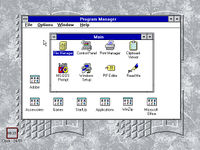
|
Windows 3.1: 6 April 1992 MS-DOS 6: November 1993 |
8GB | 32MB | 30 September 2011 | Runs legacy software such as Adobe Photoshop 3.0 and Microsoft Office 4. |
| MS-DOS 6 Windows for Workgroups 3.11 |
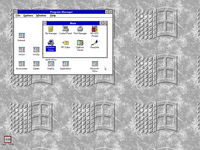
|
Windows for Workgroups 3.11: 11 April 1993 MS-DOS 6: November 1993 |
8GB | 32MB | 14 August 2012 | Created to display the more powerful version of Windows 3.11. Also notable as the only Windows 3.x OS capable of running in 256-colour SVGA at 1024x768 resolution in VMware Workstation. |
| Windows 95 | 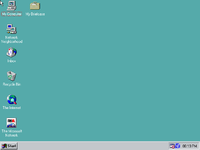
|
24 August 1995 | 8GB | 64MB | 6 August 2011 | Runs legacy software such as Microsoft Office 95 and Internet Explorer 1.0. The Windows 95 machine was the first virtual machine to be acquired and started, and despite its inability to run at higher SVGA resolutions and colour depth, is considered one of the Centre's cornerstone machines. |
| Windows NT 4.0 | 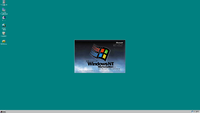
|
24 August 1996 | 4GB | 256MB | 11 August 2012 | Runs much the same software as the Windows 95 machine, however it has the distinct difference of SVGA capabilities, enabling it to run in 32-bit True Color at 1920x1080 resolution. Partitioning issues meant that this machine has the smallest hard drive at 4GB. |
| Windows Memphis | File:NCC WinMemphis.png | 7 February 1997 | 8GB | 64MB | 12 August 2011 | Curiously, Memphis bears more resemblance to Windows 95 than Windows 98, with the exception of some Internet Explorer integration (such as the Start Menu labelled with "IE4 Preview Release") and the placement of a Show Desktop button (albeit placed to the right of the clock, much like Windows 7 and 8), although when issued it was only early in the Windows 98 development stage. Unfortunately this machine is highly unstable and can only be run in Safe Mode. |
| Windows 98 | 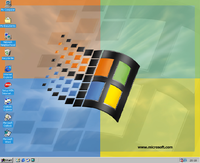
|
25 June 1998 | 20GB | 512MB | 7 August 2011 | Runs legacy software such as Microsoft Office 97 and Windows Media Player 6.4. The Windows 98 machine is a popular exhibit and has been visited many times. The original Windows 98 machine had a 24GB hard drive and 256MB RAM, however when it was migrated to its new host on 10 August 2012 the hardware was changed to a 20GB hard drive and 512MB RAM with a 1920x1080 resolution. |
| Windows Neptune | 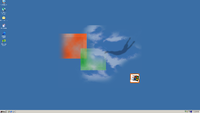
|
27 December 1999[8] | 8GB | 256MB | 11 August 2012 | The first beta software acquired by the Centre. |
| Windows 2000 | 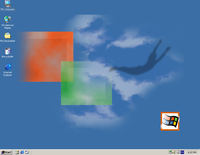
|
17 February 2000 | 24GB | 256MB | 10 August 2011 | Runs legacy software such as Midtown Madness 2 and Internet Explorer 5. Often used when the Windows 98 and Windows Me machines are unable to run a program. |
| Windows Whistler 2250 | 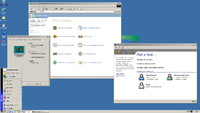
|
13 July 2000 | 24GB | 256MB | 13 August 2012 | The Whistler 2250 machine proved to be one of the most difficult to install, alongside a Whistler 2267 machine that was never able to be started. The machine was installed directly from MS-DOS 6.22 but has no time limit due to the removal of the build's "timebomb" which shut off access to the build after a certain period. The clock is however set to the year 2000. |
| Windows Me | 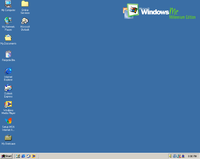
|
14 September 2000 | 24GB | 256MB | 10 August 2011 | Runs legacy software such as WebTV for Windows and Windows Media Player 7. Acquired for nostalgic purposes in the same vein as the Windows 98 machine was. |
| Windows XP | 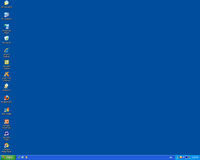
|
25 October 2001 | 126GB | 512MB | 12 September 2009 (added to Centre on 7 August 2011) |
Runs legacy software such as Microsoft Bob[9] and Microsoft Office 2000. |
Technical Repair Centre (Havilland)
Maintenance centre with two late-Windows 9x systems running off their original towers. Because of this both machines are referred to as "Tower" machines. The Technical Repair Centre also houses, alongside the two "Tower" machines, five other computer towers in various states of repair and running various operating systems.
| Operating System(s) | Image | Release date | Hard drive space | RAM | Acquisition | Manufacturer and make | Notes |
|---|---|---|---|---|---|---|---|
| Windows 98 | 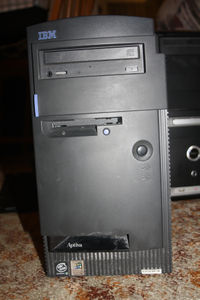
|
25 June 1998 | 1.98GB | 64MB or 256MB[10] | 1998 (added to Centre on 30 September 2011) |
IBM Aptiva | The weakest machine run by the Centre, the Windows 98 machine was constructed just after the release of Windows 98, and functioned well until it completely failed in 2005. In 2008 a new copy of Windows 98 was installed on the hard drive, and after three years of laying inactive was successfully restarted in mid-2011. Its weakness stems from a low amount of RAM in its tower, a 1.98GB hard drive and a limited video card capability that can only display either sixteen colours or monochrome. |
| Windows Me | 
|
14 September 2000 | 9GB | 64MB | 9 December 2006 (added to Centre on 7 August 2011) |
The PC Company | It is believed this machine was assembled sometime in late 2000 or early 2001 by The PC Company (now defunct). Despite overwhelming criticism of the Windows Me operating system, this system has never crashed and over six years after its acquisition it still runs perfectly, if a little slow due to its low RAM capacity. |
Future additions
The Centre's curator Daniel Anderson has noted that the Centre would be interested in acquiring other Microsoft-built systems including DOS 5, Windows 3.0 and Windows NT 3.x as well as other systems such as IBM's OS/2.[3]
References
- ↑ "Windows 98, Windows 98 SE, and Windows Me Support ends on July 11, 2006", Microsoft. Retrieved 25 January 2012.
- ↑ Ward, Mark (11 July 2006). "Technology | Microsoft shuts down Windows 98", BBC News. Retrieved 25 January 2012.
- ↑ 3.0 3.1 The Sirocco Times (30 September 2011) ""NCC gains DOS, Windows 3.1" The Sirocco Times. Retrieved 25 January 2012.
- ↑ The Sirocco Times (15 April 2012) "Premier hails technological upgrade as a 'major triumph'" The Sirocco Times. Retrieved 17 January 2013.
- ↑ 5.0 5.1 The Sirocco Times (5 August 2012) "Sirocco begins scientific research" The Sirocco Times. Retrieved 5 August 2012.
- ↑ The Sirocco Times (11 August 2012) "Windows Neptune, NT 4.0 added to Centre" The Sirocco Times. Retrieved 11 August 2012.
- ↑ 7.0 7.1 The Sirocco Times (22 October 2013) "NCC begins major expansion" The Sirocco Times. Retrieved 22 October 2013.
- ↑ Windows Neptune was never released, instead it was merged with Windows Odyssey to form Windows Whistler, which later became Windows XP.
- ↑ Microsoft Bob is installed on the Windows XP machine as it was the first to be acquired and allowed the use of Bob on the Windows 7 host machine.
- ↑ It is not known exactly how powerful the Windows 98 Tower machine's RAM is as it has run on both 64MB and 256MB RAM in its history, however performance tests suggest the tower contains 64MB RAM due to its sluggish nature.